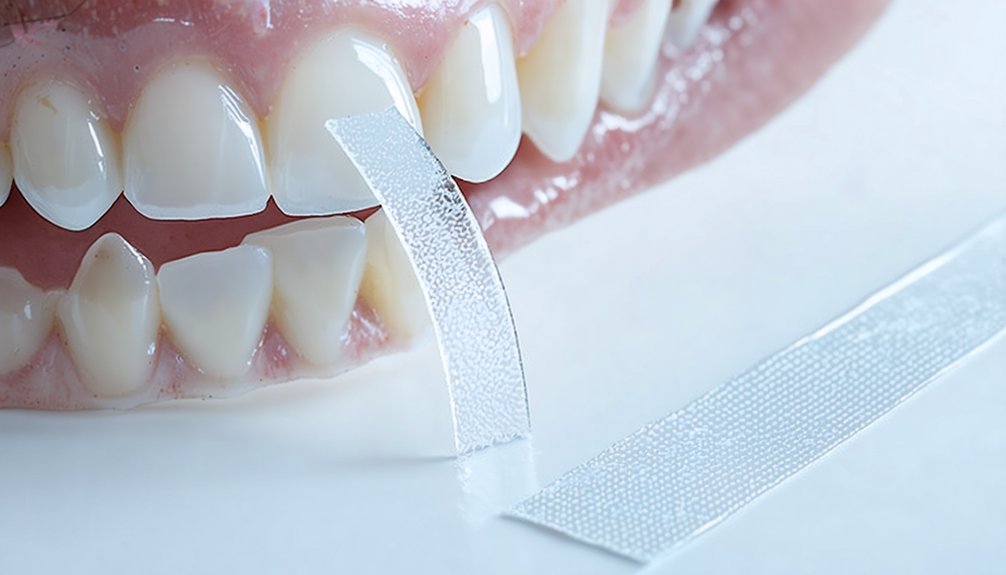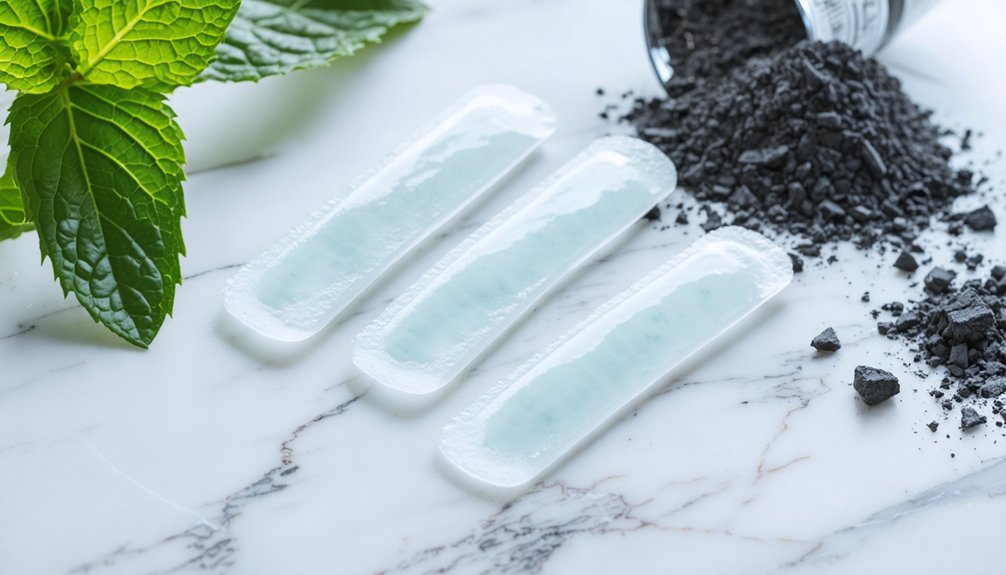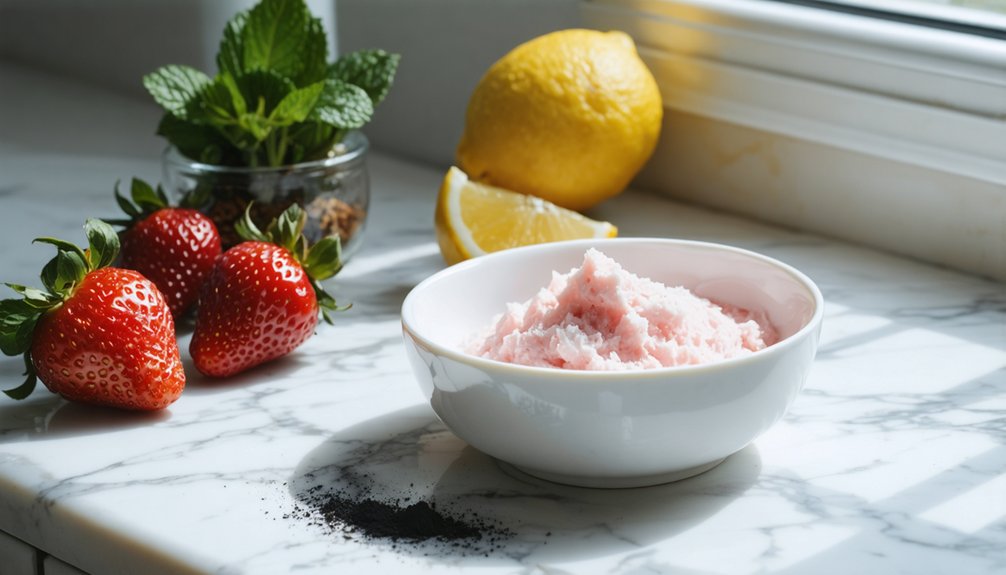You’ll find effective peroxide-free whitening strips that use innovative compounds like PAP+ and natural enzymes such as bromelain and papain to safely brighten teeth. These alternatives deliver noticeable results within 1-3 days, with full transformations possible in 14 days of consistent use. Clinical studies show they can achieve up to 7 shades of improvement while minimizing sensitivity and protecting enamel integrity. Discover how these gentle yet powerful options can transform your smile without harsh chemicals.
Key Takeaways
- PAP+ formulations with calcium and nano-hydroxyapatite provide effective whitening while protecting tooth enamel without peroxide-related sensitivity.
- Natural enzyme products containing bromelain, papain, and ficin break down stains through protein degradation with minimal sensitivity.
- Dead Sea salt and essential oil combinations offer natural whitening benefits while maintaining enamel integrity.
- Baking soda-based strips combined with hydroxyapatite effectively lift stains while strengthening tooth structure.
- Non-peroxide alternatives show comparable whitening results to peroxide strips, with visible improvements within 1-3 days of use.
Understanding Non-Peroxide Whitening Technology
While traditional whitening strips rely heavily on peroxide-based formulas, non-peroxide whitening technology has emerged as a gentler alternative that uses innovative chemical compounds to achieve tooth brightening effects.
The non-peroxide efficacy centers on compounds like phthalimidoperoxycaproic acid (PAP), which oxidizes stains without generating harmful free radicals. Studies indicate that PAP provides eight shade improvements in just six 10-minute treatments.
When you’re comparing ingredients, you’ll find that PAP+ formulations often incorporate calcium and nano-hydroxyapatite to protect and remineralize enamel during treatment.
Additionally, these formulas utilize active oxygen release through compounds like calcium lactate gluconate to enhance whitening while preserving tooth structure.
Enzyme-based technologies featuring bromelain, ficin, and papain offer another promising avenue, delivering whitening results that approach traditional peroxide treatments while maintaining better biocompatibility and reduced risk of sensitivity. In vitro studies show these natural enzymes achieve similar color changes to carbamide peroxide without causing significant enamel damage.
Natural Enzymes That Power Modern Whitening Strips
Modern whitening strips increasingly harness the power of natural enzymes as effective alternatives to peroxide-based formulations.
These enzymes deliver remarkable stain removal through gentle protein degradation rather than harsh chemical oxidation, preserving your enamel’s integrity while achieving noticeable results. The technology combines RED and BLUE light to enhance the enzymatic whitening process. The daily 10-minute application ensures optimal results while fitting easily into any schedule.
Three key enzymes demonstrate superior enzyme efficacy in clinical studies:
- Bromelain from pineapple stems shows the highest whitening potential while maintaining excellent cell viability
- Papain extracted from papaya provides gentle yet effective breakdown of surface stains
- Ficin derived from fig latex offers broad-spectrum activity against various types of discoloration
When combined in optimized pH formulations, these proteolytic enzymes work synergistically to break down stain molecules while protecting sensitive oral tissues.
You’ll find these ingredients particularly beneficial for patients seeking gentler alternatives to traditional peroxide treatments.
Clinical Evidence Behind Peroxide-Free Options
You’ll find compelling clinical evidence supporting peroxide-free whitening strips, with studies showing they achieve significant tooth color improvements while causing minimal sensitivity.
Research validates that natural enzyme-based formulations can deliver visible whitening results comparable to traditional peroxide options over 7-14 day treatment periods. Key ingredients like Dead Sea salt and essential oils provide natural whitening properties while maintaining oral comfort.
The safety data demonstrates especially lower rates of adverse effects compared to peroxide strips, making these alternatives particularly suitable for patients with sensitive teeth or those prone to oral irritation. A recent clinical study demonstrated that just one 30-minute application produced a mean whitening change of 4.73, exceeding the visible threshold for tooth color improvement.
Research Validates Natural Methods
Recent clinical research has revealed mixed results regarding the efficacy of natural tooth whitening alternatives.
While consumer awareness and interest in natural solutions continue to grow, scientific validation remains limited.
Professional studies indicate that many traditional methods require additional research to confirm their effectiveness and safety. As clinical trials show, peroxide-based treatments consistently deliver more predictable whitening results compared to natural alternatives.
Key findings from current research:
- Baking soda demonstrates effectiveness for surface stain removal but requires careful application to prevent enamel damage.
- Enzyme-based methods using bromelain or papain show promising potential as whitening agents.
- Natural abrasives can help with stain removal when used appropriately, though overuse risks enamel erosion.
Oil pulling with coconut oil has shown promising results in reducing bacteria and plaque that contribute to tooth discoloration.
While preliminary evidence suggests some natural methods may offer viable alternatives to peroxide-based products, more thorough clinical trials are necessary to establish definitive efficacy and safety standards for these approaches.
Safety Data Shows Promise
While peroxide-based whitening products have dominated the market for decades, clinical evidence now validates the safety and efficacy of peroxide-free alternatives.
You’ll find compelling data showing significant sensitivity reduction with non-peroxide strips compared to traditional peroxide options. The study found that conventional whitening with 20% carbamide peroxide caused notably higher tooth sensitivity across all measurement points compared to other methods. Clinical trials demonstrate these alternatives achieve noticeable whitening results while causing minimal enamel surface alterations.
Research confirms ingredient effectiveness through extensive cytotoxicity testing, particularly with components like bromelain that show no harmful effects on human fibroblasts.
You can trust that non-peroxide formulations utilizing PAP, enzymes, and sodium bicarbonate work through gentler mechanisms than harsh oxidation. This makes them especially suitable for patients with sensitivity concerns.
The evidence is clear – you’re able to offer your patients effective whitening solutions that prioritize both results and comfort.
Top Brands Leading The Chemical-Free Movement
As consumer demand for natural oral care solutions continues to surge, several innovative brands have emerged at the forefront of chemical-free teeth whitening. Through detailed brand comparisons and ingredient analysis, you’ll find leading companies prioritizing both effectiveness and safety in their formulations. The teeth whitening market reached $7.2 billion in 2022, reflecting growing consumer interest in natural alternatives.
Brite and Jason offer vegan-based options featuring coconut oil and calcium carbonate, delivering gentle whitening without sensitivity.
SNOW’s organic whitening kit combines natural components with dental technology, earning endorsements from 9 out of 10 dentists.
Primal Life’s peroxide-free strips and pens exclude synthetic chemicals while providing stain-repelling properties.
These pioneering brands demonstrate that effective whitening doesn’t require harsh chemicals. By incorporating plant-based ingredients and eliminating controversial additives, they’re revolutionizing the whitening industry while maintaining professional-grade results for your patients seeking natural alternatives.
Safety Profile of Enzyme-Based Whitening Methods

Studies examining enzyme-based whitening agents have revealed compelling safety advantages over traditional peroxide treatments. You’ll find that enzymes like bromelain and papain demonstrate near-perfect cell viability while maintaining whitening efficacy, compared to peroxide’s potentially harmful effects on cell health.
The enzyme safety profile excels in three critical areas: it preserves enamel integrity without causing surface alterations, considerably reduces tooth sensitivity and gingival irritation, and offers anti-inflammatory benefits that support oral tissue health.
Unlike peroxide-based products that can lead to mineral loss and increased surface roughness, enzyme-based whitening methods work gently on stains without compromising tooth structure. You can confidently recommend these alternatives to clients seeking effective whitening without the risks associated with traditional peroxide treatments.
Real Results: Before and After Comparisons
Building on the safety advantages of enzyme-based whitening methods, real-world results demonstrate compelling effectiveness for peroxide-free alternatives.
Clinical studies confirm you’ll achieve noticeable before-after transformations within 14 days of consistent use, matching the results of traditional 6% peroxide products.
- You’ll typically see initial improvements within 1-3 days, with gradual whitening progression over the full two-week treatment period.
- Your results can reach up to 7 shades lighter when following the twice-daily, 15-minute application protocol.
- You’ll experience enhanced user experience through mess-free strips that dissolve completely, eliminating the need for removal.
To maximize your results, maintain consistent twice-daily applications and avoid eating or drinking for 30 minutes post-treatment.
This disciplined approach guarantees ideal stain reduction and sustained whitening outcomes for your patients.
Why Sensitive Teeth Benefit From Peroxide-Free Solutions

When traditional peroxide-based whitening treatments trigger tooth sensitivity, peroxide-free solutions offer a gentler path to a brighter smile.
You’ll find that these natural alternatives work by avoiding the oxidation process that penetrates your enamel and irritates dental nerves.
If you’re prone to sensitivity triggers, peroxide-free options utilize ingredients like baking soda, hydroxyapatite, and plant-based compounds that lift stains without compromising your enamel integrity.
These formulations protect your teeth’s natural structure while delivering effective whitening results. Instead of exposing dentinal microtubules, which can lead to sharp pain and discomfort, these gentle alternatives support long-term oral health by maintaining enamel strength.
You’ll also benefit from added ingredients like potassium nitrate and fluoride, which help fortify your teeth while reducing sensitivity risks during the whitening process.
Application Tips for Maximum Effectiveness
To maximize whitening strip effectiveness, you’ll want to time your application when teeth are clean but not immediately after brushing, and avoid extreme temperature foods or drinks beforehand.
Position each strip carefully against your teeth, pressing firmly to eliminate air pockets while ensuring the strip doesn’t overlap onto your gums.
Before applying, thoroughly clean and dry your teeth, removing all debris and moisture that could interfere with the strip’s adhesion and whitening action.
Timing and Temperature Matters
Temperature control plays an essential role in maximizing the effectiveness of teeth whitening treatments. Your timing strategies and proper temperature management directly impact both results and comfort.
Store whitening products in cool environments to preserve their potency, as heat exposure can degrade active ingredients before application.
- Apply treatments in a moderate temperature environment, avoiding extreme heat or cold that could compromise effectiveness.
- Wait 30-60 minutes after whitening before consuming hot or cold beverages to minimize sensitivity.
- Schedule shorter, consistent applications rather than extended sessions to protect enamel health.
Remember that excessive heat during storage or application won’t accelerate results – instead, it may reduce efficacy and increase sensitivity.
Maintaining proper temperature control throughout the whitening process guarantees the best outcomes while protecting your dental health.
Proper Strip Placement Guide
Proper strip placement serves as the foundation for achieving perfect whitening results.
Begin by thoroughly drying your teeth to guarantee peak strip adhesion. Position each strip’s top edge just below the gum line, carefully avoiding contact with soft tissue to prevent irritation. The gel-coated side must face directly toward your tooth enamel.
For proper strip alignment, press gently to secure full coverage across front teeth surfaces while maintaining gum protection. You’ll want to wrap the strips slightly around tooth edges for better hold, but avoid overlapping on adjacent teeth.
If a strip becomes displaced, remove it immediately and apply a new one. Remember to keep your mouth relaxed during wear time, and don’t eat, drink, or disturb the strips to maintain consistent contact with your enamel.
Pre-Treatment Cleaning Protocol
Before beginning any whitening treatment, following a thorough pre-treatment cleaning protocol will greatly enhance your results and minimize potential complications. Proper oral hygiene practices and cleaning techniques are essential for ideal whitening effectiveness.
Start by conducting a complete dental cleaning routine to make sure your teeth are free from debris and plaque.
- Brush thoroughly and floss between all teeth to remove surface debris and interproximal residues that could interfere with the whitening process.
- Rinse with an antibacterial mouthwash to reduce oral bacteria and create an ideal environment for treatment.
- Schedule a professional cleaning within 4-6 months of treatment to remove stubborn tartar and expose natural tooth surfaces.
Remember to maintain clean, dry surfaces during application, as moisture can reduce whitening efficacy.
These preparatory steps help make sure uniform results and maximize your whitening treatment’s success.
Long-Term Enamel Protection Strategies
Maintaining your enamel’s long-term health requires a thorough approach that combines daily oral hygiene, strategic dietary choices, and professional dental care.
Your enamel care regimen should include brushing twice daily with fluoride toothpaste and using a soft-bristled brush to prevent abrasion.
Focus on dietary influence by limiting acidic foods and drinks while increasing calcium-rich options like dairy and leafy greens.
Stimulate saliva production through sugar-free gum containing xylitol, and stay well-hydrated throughout the day.
You’ll want to complement these efforts with professional interventions, including regular dental checkups every six months and protective measures like sealants when recommended.
Remember that while fluoride can help reverse early demineralization, you can’t regrow lost enamel, making prevention your most powerful strategy for long-term protection.
Frequently Asked Questions
Can I Use Peroxide-Free Whitening Strips While Pregnant or Breastfeeding?
You should avoid using whitening strips during pregnancy or breastfeeding due to safety considerations. Even peroxide-free options lack conclusive research on pregnancy effects. Consult your healthcare provider for safer alternatives.
How Long Should I Wait After Eating Before Using Non-Peroxide Whitening Strips?
You’ll wait until time stands still – or at least 30 minutes after eating before applying whitening strips. For best results, brush your teeth and make certain they’re completely clean beforehand.
Will Peroxide-Free Whitening Strips Work on Dental Crowns or Veneers?
You won’t achieve whitening effectiveness on dental crowns or veneers with peroxide-free strips. These dental restorations are made from non-porous materials that don’t respond to whitening agents.
Can I Drink Coffee Immediately After Using Enzyme-Based Whitening Products?
While enzyme treatments maintain enamel safety, you’ll want to wait 30 minutes before coffee consumption to prevent immediate restaining. Your whitening results will last longer with this brief delay.
Do Peroxide-Free Whitening Strips Have an Expiration Date?
Yes, your peroxide-free strips will expire. Check their whitening strip longevity, usually 1-2 years from manufacture. Watch for expiration indicators like texture changes, discoloration, or unusual odors.
References
- https://www.nature.com/articles/s41598-020-66733-z
- https://pmc.ncbi.nlm.nih.gov/articles/PMC9915942/
- https://pmc.ncbi.nlm.nih.gov/articles/PMC12384575/
- https://lunddental.com/teeth-whitening/teeth-whitening-without-peroxide/
- https://www.nature.com/articles/s41405-024-00227-2
- https://www.frontiersin.org/journals/dental-medicine/articles/10.3389/fdmed.2021.687507/full
- https://us.dental-tribune.com/news/non-peroxide-whitening-strips-offer-bright-competition/
- https://health.clevelandclinic.org/is-teeth-whitening-safe
- https://www.todaysrdh.com/a-look-at-pap-as-an-alternative-to-hydrogen-peroxide-based-teeth-whitening/
- https://dentistry.llu.edu/sites/dentistry.llu.edu/files/2022-11/2022-opd-whitening-strips.pdf



